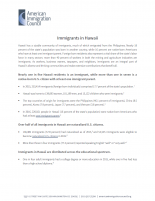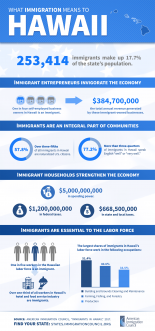- Fact Sheet
Immigrants in Hawaii
Published
Hawaii has a sizable community of immigrants, many of whom emigrated from the Philippines. Nearly one in five people who live in Hawaii was born in another country, while one in seven is a native-born American who has at least one immigrant parent. Foreign-born residents also represent a vital share of the state’s labor force in many sectors: over a third of healthcare support workers are immigrants, as are nearly two-fifths of the state's farmers, fishers, and foresters. Immigrants own over a quarter of businesses in Hawaii. As neighbors, business owners, taxpayers, and workers, immigrants are an integral part of Hawaii’s diverse and thriving communities and make extensive contributions that benefit all.
Nearly one in five Hawaii residents is an immigrant, while one in seven residents is a native-born U.S. citizen with at least one immigrant parent.
- In 2018, 266,147 immigrants (foreign-born individuals) comprised 19 percent of the population.
- Hawaii was home to 145,237 women, 105,564 men, and 15,346 children who were immigrants.
- The top countries of origin for immigrants were the Philippines (45 percent of immigrants), China (9 percent), Japan (8 percent), Korea (6 percent), and the Marshall Islands (4 percent).
- In 2018, 213,848 people in Hawaii (15 percent of the state’s population) were native-born Americans who had at least one immigrant parent.
Nearly three in five immigrants in Hawaii are naturalized U.S. citizens.
- 155,756 immigrants (59 percent) had naturalized as of 2018, and 48,828 immigrants were eligible to become naturalized U.S. citizens in 2017.
- More than three-quarters (78 percent) of immigrants reported speaking English “well” or “very well.”
Immigrants in Hawaii are distributed across the educational spectrum.
- More than a quarter (28 percent) of adult immigrants had a college degree or more education in 2018, while almost one-fifth (19 percent) had less than a high school diploma.
|
Education Level |
Share (%) of All Immigrants |
Share (%) of All U.S.-Born |
|---|---|---|
|
College degree or more |
28 |
35 |
|
Some college |
27 |
33 |
|
High school diploma only |
26 |
27 |
|
Less than a high school diploma |
19 |
5 |
|
Source: U.S. Census Bureau, 2018 American Community Survey 1-Year Estimates. |
||
Nearly 30,000 U.S. citizens in Hawaii live with at least one family member who is undocumented.
- 45,000 undocumented immigrants comprised 17 percent of the immigrant population and 3 percent of the total state population in 2016.
- 60,202 people in Hawaii, including 29,223 U.S. citizens, lived with at least one undocumented family member between 2010 and 2014.
- During the same period, about 4 percent of children in the state were U.S. citizens living with at least one undocumented family member (13,536 children in total).
Hawaii is home to hundreds of Deferred Action for Childhood Arrivals (DACA) recipients.
- Approximately 340 active DACA recipients lived in Hawaii as of March 2020, while DACA has been granted to about 368 people in total since 2012.
- As of 2019, 11 percent of DACA-eligible immigrants in Hawaii had applied for DACA.
- Fewer than a thousand Hawaii residents would satisfy all but the educational requirements for DACA, and less than a thousand would become eligible as they grew older.
Almost one in four workers in Hawaii is an immigrant, making up a vital share of the state’s labor force across industries.
- 161,938 immigrant workers comprised 23 percent of the labor force in 2018.
Immigrant workers were most numerous in the following industries:
|
Industry |
Number of Immigrant Workers |
|---|---|
|
Accommodation and Food Services |
36,591 |
|
Health Care and Social Assistance |
21,891 |
|
Retail Trade |
21,266 |
|
Public Administration |
12,991 |
|
Administrative & Support; Waste Management; and Remediation Services |
12,530 |
|
Source: Analysis of the U.S. Census Bureau’s 2018 American Community Survey 1-year PUMS data by the American Immigration Council. |
|
- The largest shares of immigrant workers were in the following industries:
|
Industry |
Immigrant Share (%) |
|
Accommodation and Food Services |
33 |
|
Administrative & Support; Waste Management; and Remediation Services |
30 |
|
Agriculture, Forestry, Fishing, and Hunting |
30 |
|
Other Services (except Public Administration) |
29 |
|
Transportation and Warehousing |
27 |
|
Source: Analysis of the U.S. Census Bureau’s 2018 American Community Survey 1-year PUMS data by the American Immigration Council. |
|
Immigrants are an integral part of the Hawaii workforce in a range of occupations.
- In 2018, immigrant workers were most numerous in the following occupation groups:
|
Occupation Category |
Number of Immigrant Workers |
|---|---|
|
Food Preparation and Serving Related |
21,591 |
|
Building and Grounds Cleaning & Maintenance |
20,763 |
|
Sales and Related |
20,242 |
|
Office and Administrative Support |
17,183 |
|
Transportation and Material Moving |
16,130 |
|
Source: Analysis of the U.S. Census Bureau’s 2018 American Community Survey 1-year PUMS data by the American Immigration Council. |
|
- The largest shares of immigrant workers were in the following occupation groups:
|
Occupation Category |
Immigrant Share (%) |
|---|---|
|
Building and Grounds Cleaning & Maintenance |
44 |
|
Farming, Fishing, and Forestry |
38 |
|
Production |
36 |
|
Healthcare Support |
35 |
|
Food Preparation and Serving Related |
29 |
|
Source: Analysis of the U.S. Census Bureau’s 2018 American Community Survey 1-year PUMS data by the American Immigration Council. |
|
- Undocumented immigrants comprised 5 percent of Hawaii’s workforce in 2016.
Immigrants in Hawaii have contributed billions of dollars in taxes.
- Immigrant-led households in the state paid $1.7 billion in federal taxes and $960.7 million in state and local taxes in 2018.
- Undocumented immigrants in Hawaii paid an estimated $65.3 million in federal taxes and $47.6 million in state and local taxes in 2018.
- DACA recipients and DACA-eligible individuals in Hawaii paid an estimated $2.5 million in state and local taxes in 2018.
As consumers, immigrants add billions of dollars to Hawaii’s economy.
- Hawaii residents in immigrant-led households had $6.4 billion in spending power (after-tax income) in 2018.
Immigrant entrepreneurs in Hawaii generate hundreds of millions of dollars in business revenue.
- 21,250 immigrant business owners accounted for 26 percent of all self-employed Hawaii residents in 2018 and generated $441.7 million in business income.
We can't let the government keep us in the dark.
Join us in demanding transparency and holding them accountable in court to protect our democracy.
Donate Now

